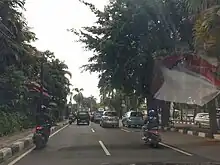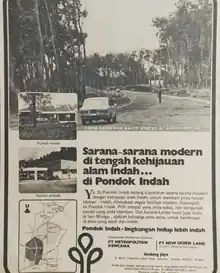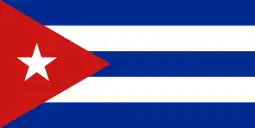Pondok Indah
Pondok Indah is an upscale residential area in Pondok Pinang, Kebayoran Lama, South Jakarta, Indonesia. Dubbed as the Beverly Hills of Indonesia, this is a much sought-after suburb by expatriates, conglomerates, celebrities, and government officials. This area was built by the Metropolitan Kentjana Group in the 70s into the most prestigious and complete residential complex and commercial area in Indonesia. Houses in this suburb can run upwards to millions of U.S. dollars.
 The Metro Pondok Indah street as the main street of Pondok Indah residence | |
| Location | Pondok Pinang, Kebayoran Lama, South Jakarta, Jakarta, Indonesia. |
|---|---|
| Status | Completed |
| Groundbreaking | c. 1970s |
| Companies | |
| Owner | Metropolitan Kentjana |
| Manager | Pondok Indah Group |
| Technical details | |
| Size | 473 ha |
Many mansions in the area comprise one to three floors, with designated quarters for household staff. Many of the larger mansions are inhabited by wealthy Indonesians. The Jakarta Post estimates that 74.5% of residents in Pondok Indah are expatriates, following their annual survey of Indonesia. (Jakarta Post, issue 6 edition 21, 6 January 2007) A posh shopping complex, Pondok Indah Mall, caters to residents.
Naming
The name Pondok Indah is a combination of two Indonesian words, "Pondok" and "Indah". According to Ciputra, the name "pondok" refers to Pondok Pinang, the name of the plantation area which became the development area of the residence and also the administrative village (Kelurahan) of Kebayoran Lama. Literally, pondok means residence or house, while indah means beautiful. Thus, if the two words are combined, it become "a beautiful house". The name Pondok Indah was in accordance with Ciputra's wishes to made it as the most luxurious residence in Jakarta.
History
Background
Before becoming a luxurious residence as of today, Pondok Indah was previously a vast expanse of dry fields, rice fields, and also a rubber and secondary crops plantations.[1][2]
At one point, the area was visited by an architect and urban developer, Ciputra. At that time, he had to pass through a small road that was only 6 meters wide and in the form of a cobblestone road to reach the area that would become the forerunner of Pondok Indah, now the small road in the form of rocks has become Jalan Radio Dalam Raya.[1]
According to Ciputra, the plantation area is very strategic, because it is bordered by Jalan Ciputat Raya (which was previously part of the National Road from Jakarta to Bogor that passed through Palmerah, Ciputat, and Parung) to the west and Lebak Bulus to the south. The most important thing was because the plantation area is located near Kebayoran Baru, the first modern satellite city in Indonesia. The other reason was because the plantation area is not a flood-prone area and the soil does not contain salt like in the northern region of Jakarta. The area was also still a stretch of mild forest and a source of clean water.[1]
Ciputra had a feeling that Jakarta would reached its population boom in the 1970s that would made the city highly crowded. He predicted that a large number of vertical housings would occupy Jakarta in the future. That became the reason for him to redevelop the plantation area into a new satellite city.[2]
Realization
To turn the plantation into a prestigious residence, Ciputra took businessman Liem Sioe Liong. Even though at that time, Liem wanted to develop Sunter, North Jakarta. However, Ciputra assesses that the area that was actually developing was in southern Jakarta because the soil and air quality were still good. Meanwhile, the Sunter area has poor soil and air quality.[1]
After listening to Ciputra's presentation, Liem also agreed to work together to finance the Pondok Pinang project. Liem gave the loan and borrowed the rest from Bank Dagang Negara (now Bank Mandiri) with a recommendation from Liem and a project guarantee. He said:
The area can be turned into a luxurious residence that will continue to shine from time to time. I can make a master plan right away. Regarding the permit to work on a project in this area, I can talk to Mr. Ali Sadikin immediately.
— [1]
The development plan of Pondok Indah as Jakarta's satellite city was considered impossible to be realized by an urban planning official, but it didn't break Ciputra's ambition to build Pondok Indah.[2]
Early development

After preparing the legal entity and the masterplan, Ciputra and his colleagues started the development of Pondok Indah area which was previously a plantation in the 1970s. The first project to be completed was the construction of a road in accordance with the mapping of plots that had been made and the construction of water channels.
At the beginning of construction, some houses were only built as examples. For the rest, Ciputra sells empty lots. This was based on the behavior of elites who want to build their own house according to their desire. Nevertheless, Ciputra also opened a request if there was a buyer who wanted to build their own house.
Ciputra was worried because the funds spent to acquire land and build road infrastructure and waterways were enormous. To work around this, Ciputra and his team built tiny houses north of Pondok Indah, precisely on Jalan Pinang Perak, Jalan Pinang Emas. The house turned out to be sold quickly. On the other hand, the plots were also invaded by buyers. He said that almost every weekend, the Pondok Indah area, which was still in the form of plots, was visited by interested parties. Most interested people were whom have been rich for a long time, and new rich people who have emerged as a result of business activity.[1]
Facilities
Education
This area is served by many schools such as follows:
- Jakarta Intercultural School Pondok Indah Campus[3]
- Bakti Mulya 400
- Tirta Marta BPK Penabur
- Don Bosco
- Raffles Christian School
- SDI Harapan Ibu
- HighScope Indonesia, Pondok Indah
Healthcare
- Pondok Indah Hospital
Shopping mall and commercial
- Pondok Indah Mall
- PIM1
- Street Gallery
- PIM2
- PIM3
- Ranch Market Pondok Indah
- Decathlon Pondok Indah
- Metro Duta
- Niaga Hijau
Accommodation
- InterContinetal Jakarta Pondok Indah (adjoined with PIM2)
- Swiss-Belhotel Pondok Indah
Places of interest
- Pondok Indah Golf Course – The golf venue of the 1983 Golf World Cup and the 2018 Asian Games.
- Pondok Indah Waterpark
Religious
- Pondok Indah Grand Mosque
Diplomatic
 Embassy of Cuba[lower-alpha 1]
Embassy of Cuba[lower-alpha 1]
Road access
Before this area began to be built, the only road access to the forerunner of Pondok Indah was Jalan Radio Dalam Raya, which at that time was only a small road and rocks. The road connects the forerunner of Pondok Indah with Indonesia's first modern satellite city, Kebayoran Baru.[1]
In the first phase of construction, Ciputra and his partners started the construction of the main road and road plots first, according to the master plan that had been prepared. The main road to the Pondok Indah area was named Jalan Metro Pondok Indah, connecting Kebayoran Lama with Lebak Bulus which previously had to pass through Jalan Ciputat Raya (which was previously part of the National Road from Jakarta to Bogor which passed Palmerah, Ciputat and Parung, before it was replaced by Jalan Metro Pondok Indah).
Pondok Indah also have an access from the TMII–Pondok Pinang section of the Jakarta Outer Ring Road which was first opened in 1995.
Transportation
TransJakarta
- BRT routes
- Corridor
 (Lebak Bulus–Pasar Baru), with two stations:
(Lebak Bulus–Pasar Baru), with two stations:
- Pondok Indah 1
- Pondok Indah 2
- Corridor
- Cross-border feeder routes
- S21 (Ciputat–CSW)
- Mikrotrans routes
- JAK-49 (Cipulir–Lebak Bulus)
- JAK-95 (Lebak Bulus–Pasar Minggu)
- JAK-102 (Lebak Bulus–Blok M)
Other buses
- Mayasari Bakti
- AC73 (Kampung Rambutan–Ciledug via Pondok Indah)
Rail transport
 North–South Line of the Jakarta MRT, with one station:
North–South Line of the Jakarta MRT, with one station:
Recreation
There are many malls located inside and near Pondok Indah. Pondok Indah Mall is the main attraction of the area as it is considered as a big shopping mall in Jakarta. Next to the mall is a water park and a golf course. There are also multiple tennis courts for residents to use.
The Pondok Indah Golf and Country Club was also the venue of the 1983 Golf World Cup.
Pondok Indah Sunday Market (PISM) offers a break from Sunday routines. The market serves the various interests of residents in the area (food, children activities, shopping, medical information, live music), as well as the meeting point for sports enthusiasts and exotic vehicle lovers. It is held annually in January. Visitors to PISM 2017 are estimated upwards of 10,000 people. Proceeds from organizing the bazaar is wholly donated to community charity projects throughout the year. The group works with Kelurahan Pondok Pinang to identify needs in the community, and often donates through RPTRA Pondok Pinang.[6][7]
References
- Irawan, Dika (12 November 2021). "Sejarah Pondok Indah, Kawasan Elite yang Dulunya Sawah & Kebun Karet". Hypeabis (in Indonesian). Retrieved 18 November 2022.
- Suhendra (27 November 2019). "Ciputra Sulap Kebun 'Tempat Jin Buang Anak' Jadi Pondok Indah". CNBC Indonesia (in Indonesian). Retrieved 6 August 2023.
- "Contact Information Archived 2015-04-13 at the Wayback Machine" (Archive). Jakarta Intercultural School. Retrieved on April 29, 2015. "Cilandak Campus Jl. Terogong Raya No. 33 Cilandak Jakarta 12430 Pondok Indah Campus Jl. Duta Indah III Pondok Indah Jakarta 12310 Pattimura Campus Jl. Pattimura Blok 1 No. 2 Keboyoran Baru Jakarta 12110"
- "Embajada de Cuba en Indonesia". Embajadas y Consulados de Cuba (in Spanish). 23 March 2016. Retrieved 4 November 2022.
- "Layanan Diplomatik Terpadu Satu Pintu - Ditjen Protkons Kemlu RI". layanandiplomatik.kemlu.go.id. Retrieved 4 November 2022.
- "Belasan PAUD di Pondok Pinang Dapat Bantuan Laptop". Pos Kota (in Indonesian). 5 February 2017.
- "Sunday Market di Pondok Pinang Meriah". Pos Kota (in Indonesian). 15 January 2017.